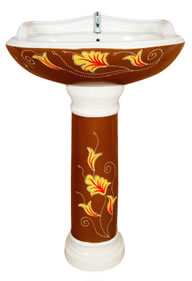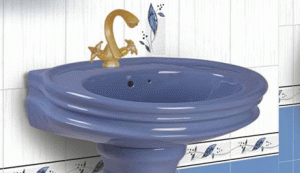 Bathing and sanitation have been considered of medical importance by man since the earliest times. Natural hot baths, bubbling baths, salt-water baths, and baths in natural waters are mentioned in writings dating back to the ancient times. A built-in bath-tub and drainage system more than 3000 years old lies in the ruins of King Nestor’s palace near Pylos, Greece. The Romanians maintained warm public baths. They also used natural mineral springs, among which were the famous hot baths located near Naples and Thermopolis. In the Middle Ages, particularly in Germany, the barber was often a bath keeper as well. In the 1600’s, bathing resorts became fashionable. In some of the resorts, people spent as long as 24 hours in the water as part of the treatment for bodily ailments.
Bathing and sanitation have been considered of medical importance by man since the earliest times. Natural hot baths, bubbling baths, salt-water baths, and baths in natural waters are mentioned in writings dating back to the ancient times. A built-in bath-tub and drainage system more than 3000 years old lies in the ruins of King Nestor’s palace near Pylos, Greece. The Romanians maintained warm public baths. They also used natural mineral springs, among which were the famous hot baths located near Naples and Thermopolis. In the Middle Ages, particularly in Germany, the barber was often a bath keeper as well. In the 1600’s, bathing resorts became fashionable. In some of the resorts, people spent as long as 24 hours in the water as part of the treatment for bodily ailments.
 A modern bath includes decorative sanitary ware which combines luxury and convenience. It has a combination of bathtub and a shower stall. Modern attitudes toward bathing fall into two general classes…….ordinary bathing for cleanliness, and special baths for luxury or health. A hand shower of the 1870’s was operated by the bather, who worked a hand lever. As the lever pumped water on the bather’s head, it also moved a back-washing brush. Early American bath tubs were modelled on the slipper-shaped bathtubs long used in Europe. The metal bathtub, built in 1805, had handles so it can be moved easily. The folding bathtub was used in apartments in the late 1800’s. The bather unfolded the tub from the wall.
A modern bath includes decorative sanitary ware which combines luxury and convenience. It has a combination of bathtub and a shower stall. Modern attitudes toward bathing fall into two general classes…….ordinary bathing for cleanliness, and special baths for luxury or health. A hand shower of the 1870’s was operated by the bather, who worked a hand lever. As the lever pumped water on the bather’s head, it also moved a back-washing brush. Early American bath tubs were modelled on the slipper-shaped bathtubs long used in Europe. The metal bathtub, built in 1805, had handles so it can be moved easily. The folding bathtub was used in apartments in the late 1800’s. The bather unfolded the tub from the wall.
 The common household device that is used to get rid of bodily wastes is actually the toilet. Toilets are one of the most important inventions that increase the hygiene greatly in the area that they are installed. They make places clean with an efficient bodily waste disposal system. Toilets work on simple operating methods, in both new and older models, though some designs have changed the manner in which new toilets flush compared to their older counterparts. New designs include a power flush system wherein, the tank water is stored within an air-filled pressure tank that is found within the larger tank. Thus, as the toilet is flushed, the water is pushed with force down through the bowl. Some modern toilets have dual flush technology, allowing you to flush the toilet using two different quantity of water. The latest ones are the multifunction toilets with two cleansing modes, along with adjustable spray with precision positioning and oscillation. The range of water closets includes Italian S-trap water closet, Italian p-trap water closet, Irani water closet, bidet water closet and Burma water closet. The “Anglo-Indian” design allows the same toilet to be used in the sitting or the squatting position. A significant move towards using less water for flushing flush toilets has resulted in the emergence of low flush toilet designs. In the very early times, only luxury hotels and wealthy people had indoor private bathrooms. In short, whatever the type, the water closet helps improve hygiene by keeping human waste away from bathing areas, allowing the toilet to remain relatively hidden, making a bathroom appear more attractive.
The common household device that is used to get rid of bodily wastes is actually the toilet. Toilets are one of the most important inventions that increase the hygiene greatly in the area that they are installed. They make places clean with an efficient bodily waste disposal system. Toilets work on simple operating methods, in both new and older models, though some designs have changed the manner in which new toilets flush compared to their older counterparts. New designs include a power flush system wherein, the tank water is stored within an air-filled pressure tank that is found within the larger tank. Thus, as the toilet is flushed, the water is pushed with force down through the bowl. Some modern toilets have dual flush technology, allowing you to flush the toilet using two different quantity of water. The latest ones are the multifunction toilets with two cleansing modes, along with adjustable spray with precision positioning and oscillation. The range of water closets includes Italian S-trap water closet, Italian p-trap water closet, Irani water closet, bidet water closet and Burma water closet. The “Anglo-Indian” design allows the same toilet to be used in the sitting or the squatting position. A significant move towards using less water for flushing flush toilets has resulted in the emergence of low flush toilet designs. In the very early times, only luxury hotels and wealthy people had indoor private bathrooms. In short, whatever the type, the water closet helps improve hygiene by keeping human waste away from bathing areas, allowing the toilet to remain relatively hidden, making a bathroom appear more attractive.

